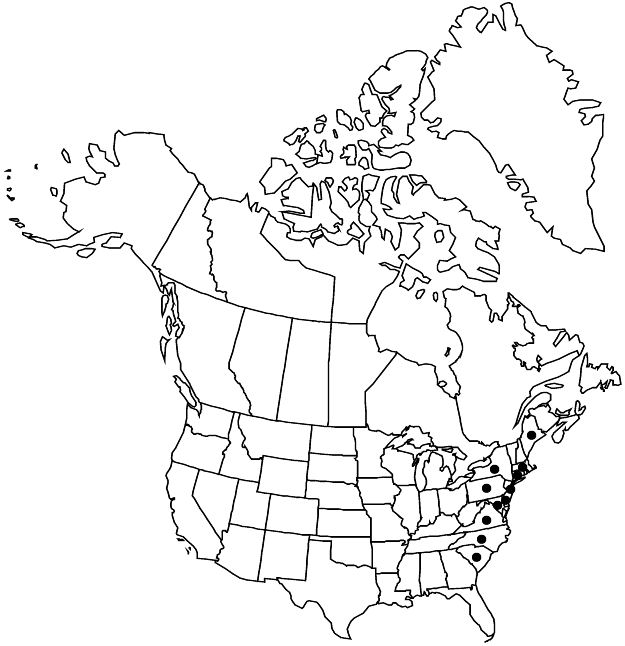Viola brittoniana
Bot. Gaz. 26: 332. 1898.
Plants perennial, acaulescent, not stoloniferous, 5–30 cm; rhizome thick, fleshy. Leaves basal, 5–9, ascending to erect, 5–9-lobed; stipules linearlanceolate, margins entire, apex obtuse; petiole 3–16 cm, usually glabrous; mid-season blades incised or lobed throughout, earliest blades lobed (plants homophyllous), similar to mid-season blades, middle and lateral blade lobes differ in width and/or shape, middle lobes lanceolate or spatulate to narrowly obovate, lateral lobes lanceolate or spatulate to falcate (each sometimes with deltate to falcate appendages or teeth along margins), 1–7 × 2–8 cm, base truncate to cordate, margins entire, ciliate, apex acute to obtuse, surfaces usually glabrous, rarely with a few strigose, hairs concentrated on veins. Peduncles 5–18 cm, usually glabrous. Flowers: sepals lanceolate to ovate, margins ciliate or eciliate, auricles 2–3 mm; petals light to soft reddish violet on both surfaces, lower 3 white basally, dark violet-veined, lateral 2 bearded, lowest 10–25 mm, sometimes bearded, spur same color as petals, gibbous, 2–3 mm; style head beardless; cleistogamous flowers on ascending to erect peduncles. Capsules ellipsoid, 10–15 mm, glabrous. Seeds beige, mottled to bronze, 1.5–2.5 mm. 2n = 54.
Phenology: Flowering Apr–Jun.
Habitat: Alluvial woods, mesic forests on slopes near streams, wet fields, salt meadows
Elevation: 0–100 m
Distribution

Conn., Del., Maine, Md., Mass., N.J., N.Y., N.C., Pa., S.C., Va.
Discussion
Britton considered Viola brittoniana similar to V. pedatifida, apparently making him the first to recognize their affinity. Both are homophyllous and similar in other characters (L. E. McKinney 1992). McKinney recognized V. brittoniana as a variety of V. pedatifida. Additional evidence (N. L. Gil-Ad 1997; A. Haines 2011) suggests that these taxa are sufficiently distinct to continue recognition as separate species.
Viola pectinata has sharply dentate leaves and is closely related to V. brittoniana, usually occurring with it. N. L. Gil-Ad (1997) made a convincing argument to recognize it as a form; A. Haines (2011) recognized it as a species. Others have considered it to be a sporadic form that may be of hybrid origin, or, as N. H. Russell (1965) suggested, is due to genetic dimorphism. We are reserving a decision on treating this taxon until additional studies are completed.
A. Haines (2011) reported that the distribution of Viola brittoniana in Maine is actually based on the hybrid V. ×insolita House (V. brittoniana × V. sororia).
Viola brittoniana reportedly hybridizes with V. cucullata (= V. ×notabilis E. P. Bicknell), V. sagittata var. sagittata (= V. ×mulfordiae Pollard), and V. sororia (= V. ×insolita).
Selected References
None.
Lower Taxa
"thick" is not a number.